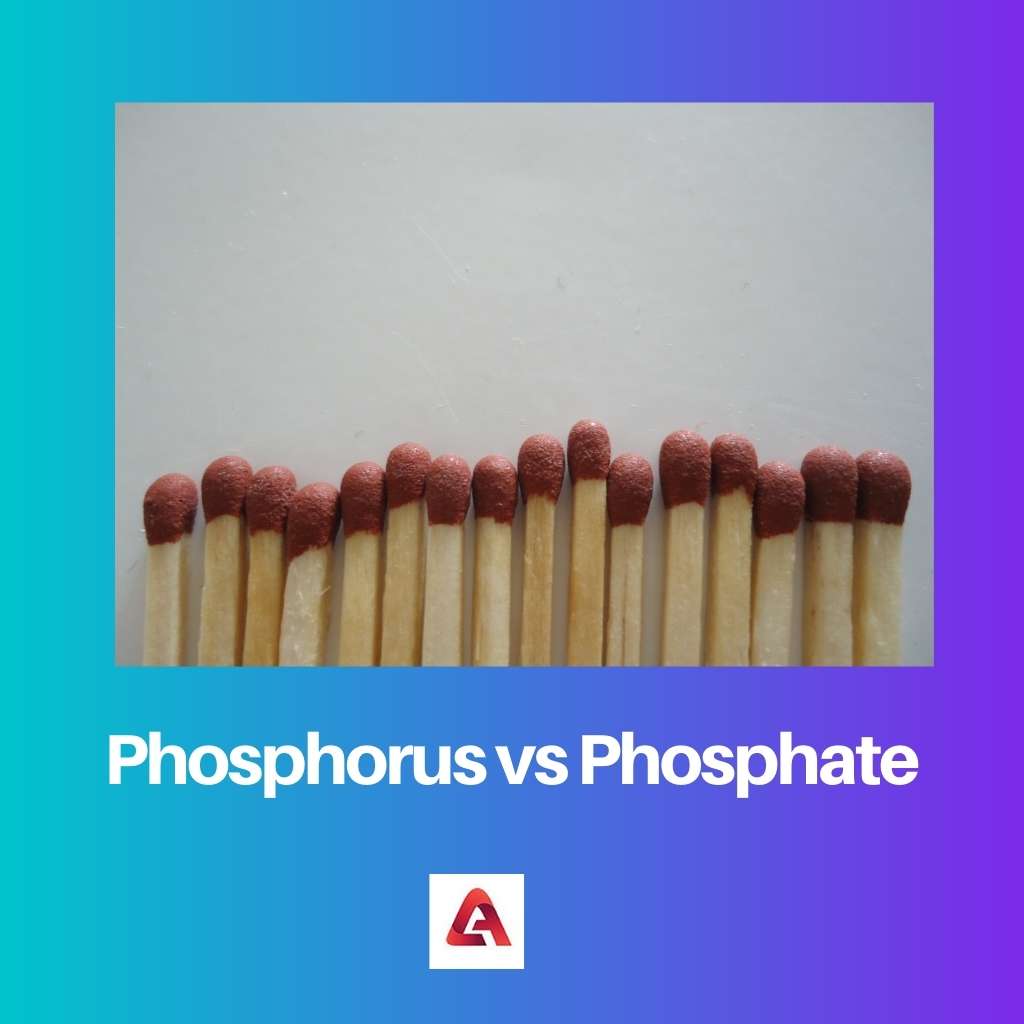Chemistry is a wide subject or field for an individual to study. It mainly includes all the reactions taking place in nature to form a new product.
The person studying the subject is involved in the different properties, nature, composition, etc., of the three different matters that are solid, liquid, and gas.
On a closer note, the change in structure, energy production or consumption, change in appearance, all of such things are incorporated in this.
Key Takeaways
- Phosphorus is a chemical element, while phosphate is a compound containing phosphorus.
- Phosphorus is essential for life and is found in DNA and cell membranes, while phosphate is important for energy storage and cell transfer.
- Phosphorus can exist in various forms, while phosphate is always a combination of phosphorus and other elements.
Phosphorus vs Phosphate
Phosphorus is a chemical element essential for life. It is a key component of DNA, RNA, and ATP (adenosine triphosphate), which is the main source of energy for cells. Phosphate is a compound that contains phosphorus and other elements, such as oxygen. It is an important source of energy for cells.

Phosphorus is the element that is found naturally occurring on the earth. The element has been placed with a significant atomic number 15 and thus lies in the Nitrogen family.
The electronic configuration of the element according to the method of the Aufbau Principle is 1s 2s2 2p6 3s2 3p3 or can be written as [Ne] 3s2 3p6. The atomic mass of the element is approximately 30.97 grams per mol.
Phosphate is the chemical by-product that is obtained from phosphoric acid after the removal of all the hydrogen atoms. The structure of the compound is in a tetrahedral symmetrical shape with one phosphate atom and four atoms of oxygen.
The compound is represented by the formula ‘PO4’ according to the norms of IUPAC Nomenclature.
Comparison Table
| Parameters of Comparison | Phosphorus | Phosphate |
|---|---|---|
| Definition | An element with multivalency and categorized as non-metal | A chemical derivative that is obtained from phosphoric acid and consists of phosphorus and oxygen |
| Molar mass | 30.97 grams per mol | 94.97 grams per mol |
| Chemical Formula | P | PO4 |
| Atomic Structure | Crystal lattice | Tetrahedral |
| Oxidation State | +3, -3, and +5 | -3 |
| Different Forms/Type | White phosphorus Red phosphorus Black phosphorus Violet phosphorus | Pyrophosphates Orthophosphates Polyphosphates Tripolyphosphates |
What is Phosphorus?
Phosphorus is among one the elements that are placed in the periodic table. The element can be found on the earth as it is naturally occurring but also in its impure form of state.
The other reason behind this is the reason of being highly reactive. It is found in an impure state.
According to scientists, the concentration of phosphorus element in the earth’s crust is approximately 1 g per kg. The element has achieved an atomic number in the periodic table to be 15, thus belonging to the Nitrogen family.
Also, the approximate atomic mass of the element is near about 30.97 grams per mol. According to the IUPAC Nomenclature, the element is represented by the chemical formula ‘P’.
The major forms of phosphorus that can be found by scientists are – red and white phosphorus (most widely known), black phosphorus, and violet phosphorus. The elements have a very distinctive role in the production of steel match sticks.
They are used as fertilizers, in water softening, a major component of bones and tooth enamel, etc.

What is Phosphate?
Phosphate is a chemical compound that is obtained or is one of the by-products of phosphoric acid. When from phosphoric acid (H3PO4), all the three bonded atoms of hydrogen are extracted or removed from the structure then the phosphate ion is formed.
The chemical formula derived from the statements is PO4. Given below is a representative of the reaction –
H3PO4 – 3H+ → PO4
The above reaction significantly shows that the chemical compound comprises one phosphate atom and 3 atoms of oxygen in its chemical structure.
The shape of the phosphate compound is in tetrahedral symmetry with sp3 hybridization.
The molar mass of the chemical compound phosphate denoted by the IUPAC is approximately near about 94.97 grams per mol.
The oxidation state showed by the compound is +5, and the different forms of the compound are – Tripolyphosphates, Orthophosphates, Pyrophosphates, Polyphosphates, etc.
Main Differences Between Phosphorus and Phosphate
- Phosphorus is a chemical element that occurs in nature and is a non-metal with multiple valencies while comparatively, on the other hand, Phosphate is also a chemical that is derived from phosphoric acid when all the H+ ions are extracted or removed from it.
- The molar mass suggested by IUPAC for the phosphorus is approximately 30.97 grams per mol, while comparatively, on the other hand, the molar mass suggested by IUPAC for the phosphate is approximately 94.97 grams per mol.
- The chemical formula derived from IUPAC is ‘P’ while comparatively, on the other hand, the chemical formula derived from IUPAC is ‘PO4’.
- The atomic structure for the element phosphate is similar to a crystal lattice, while comparatively, on the other hand, the atomic structure for the chemical molecule phosphate is in a tetrahedral shape.
- The element phosphate shows three different oxidation states in different conditions, and they are +3, -3, and +5, while comparatively, on the other hand, the chemical phosphate shows only a single oxidation state, and that is -3.
- The different forms or types of element phosphorus occurring in nature are – white phosphorus, red phosphorus (both are widely known), violet phosphorus, and black phosphorus, while comparatively, on the other hand, the different types of phosphate are – polyphosphates, tripolyphosphates, orthophosphates, pyrophosphates, etc.

References
- https://onlinelibrary.wiley.com/doi/abs/10.1111/hdi.12010
- https://www.sciencedirect.com/science/article/abs/pii/0077757974900143
- https://onlinelibrary.wiley.com/doi/abs/10.1111/j.1475-2743.2003.tb00278.x
- https://journals.lww.com/soilsci/Citation/1967/04000/Response_of_Plants_to_Phosphate_Concentration_in.1.aspx
